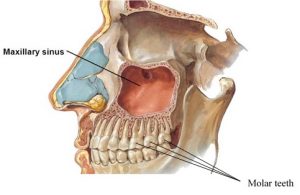If you have dentures or a missing tooth that was extracted many years ego, dental implants can be transformative in many ways. Dental implants are designed to replace and function just like a natural tooth. But before you can get a dental implant, it is essential that you have enough bone to act as the foundation for the dental implants. This is where being an INFORMED PATIENT is so critical.
On a daily basis we have patients that contact our office desiring dental implants. They usually had a tooth that was extracted – WITHOUT bone grafting, either recently or many years ego. This only means that the patient will most likely lack sufficient bone to place an implant. Subsequently a bone grafting procedure will be recommended if there is any hope of getting dental implants.
When it comes to bone grafting, the backside of the upper jaw can be especially challenging because of our natural facial anatomy. Unknown to most people, our maxillary sinuses are right above our back (Molar) teeth, naturally leaving less bone to work with when the teeth are extracted.
So anytime a patient has a molar tooth extracted, the bone will naturally reduce in its amount during the healing process. This is why bone grafting is almost always recommended in the upper jaw in order to conserve as much as bone as possible for an implant and to also prevent a permanent hole that we usually refer to as an OA-fistula (Oro-antral fistula). If there is any need for the bone grafting procedure to go into the sinus cavity, this is referred to as a “Sinus Lift”. However, what most people do not know is that sinus lifts can be done in two major ways: External and Internal.
1. External sinus lift: is reserved for more extensive bone loss, resulting from multiple missing molar teeth in the posterior of the upper jaw for many years. This is especially true if the teeth were extracted without any bone grafting. See Panorex x-ray below with multipe missing teeth in the upper jaw. The maxillary sinus cavity is noted with blue arrows and the thinning of maxillary bone high-lighted in yellow.
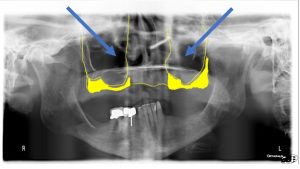
In this case, we performed an External Sinus lift approach commonly referred to as a “Caldwell Luc” approach, from the outside of the maxillary bone. See below:
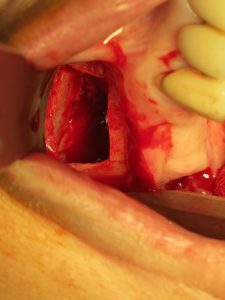
This patient underwent bilateral sinus lift using Stem Cells to generate enough bone to place multiple dental implants to replace all her missing teeth in the upper jaw, commonly referred to as the “All-on-4” implants. The Panorex below demonstrates the increase in bone as noted by the high-lighted yellow, as compared to the previous Panorex in the same patient.
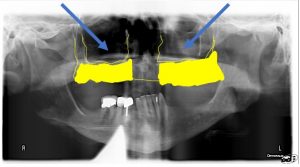
The same patient with 5 implants in the upper jaw.
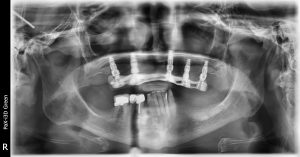
Same patient with hybrid teeth loaded on the 5 implants.
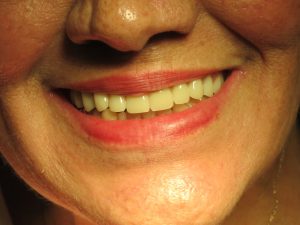
- Internal sinus lift: is usually done to prepare an extraction site for a single implant in the posterior region of the upper jaw (molars and sometimes premolars). This is usually done at the same time as the extraction, reducing the total treatment time by 50% by avoiding an additional bone grafting surgery in the future. This is why it is HIGHY recommended that bone grafting is performed anytime a tooth is extracted, especially if an implant is desired in the near future.
DO NOT LET ANYONE EXTRACT A TOOTH WITHOUT BONE GRAFTING, ESPECIALLY IF YOU WANT AN IMPLANT IN THE FUTURE.
In the case below a patient presented with an infected molar tooth #3 in the upper right side – as noted by the blue arrow. This tooth could not be saved despite two previous root canals and his general dentist and endodontist recommended an extraction and replacement with an implant. In this case the patient elected for an internal sinus lift, due to a lack of bone as noted by the yellow lines.
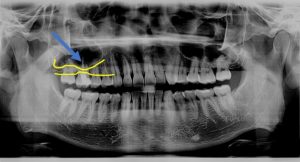
During the extraction procedure, through the same extraction site, the bone was impacted up using an osteotome (red arrow) and then the remaining space was bone grafted and covered with semi-permeable membrane and sutures to protect the grafted site. Over the next 4-6 weeks the sutures and membrane are removed.
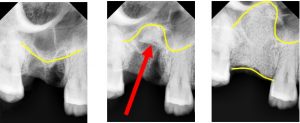
Once the sinus lift is complete, you’ll have to wait a few months for the new bony material to harden and integrate with the existing jaw bone, referred to as “osseointegration”. Subsequently, dental implants can usually be inserted 3 – 6 months (or longer), after the sinus lift. The quality and quantity of bone is confirmed using either a panorex or a 3D CBCT before the implants are placed.
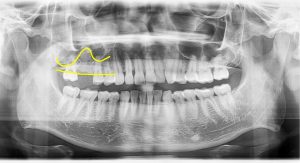
If you are tired of your loose dentures and are interested the “All-on-4” implant concept, or just have a missing tooth; give us a call at 408-358-5000 in downtown San Francisco or 408-253-6084 in Cupertino. We look forward to improving your smile!

